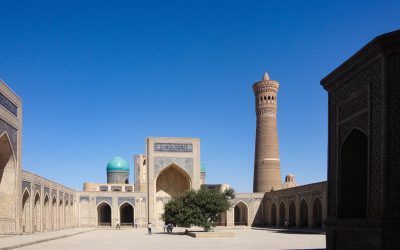TOMB OF IMAM AL-BUKHARI
The tomb is located north of Samarkand in the village of Hartang and takes about half an hour by car. One would head north on the M37 for about 20 minutes and then turn right towards Xoʻja Ismoil.
HERITAGE SITE | TOMB OF IMAM AL-BUKHARI
-
One of the most prominent hadith scholars of the Muslim world, Imam Muhammad ibn Isma`il al-Bukhari, was born in Bukhara on July 21, 810CE. His father, Isma`il ibn Ibrahim, a scholar of hadith, was a student and associate of Imam Malik RA.
-
According to the historian al-Dhahabi RA, Imam al- Bukhari began studying hadith in the year 819 CE. He memorised the works of ‘Abdullah ibn al-Mubarak RA while still a child. As his father had passed on while he was still an infant, his mother raised him. He traveled with her and his brother in search of knowledge. While still an adolescent, he began authoring books and narrating hadith.
-
At the age of sixteen, he performed the Haj together with his brother and mother and then set off on a series of travels to all the important centers of learning. He learned and exchanged information on hadith with the leading scholars of the time. It is said that he heard narrations from over 1,000 scholars and learned over 600,000 traditions.
-
After sixteen years’ absence from home, he returned to Bukhara and there drew up his al-Jami’ as-Sahih, a collection of 7,275 tested traditions, arranged in chapters so as to afford bases for a complete system of jurisprudence without the use of speculative law.
-
In the year 864CE, he settled in Nishapur. It was there that he met Muslim ibn al-Hajjaj RA who would from then on be considered his student. Political problems led him to move to Khartang, a village near Samarkand where he passed away in the year 870CE.
-
A tomb was built over his grave but then abandoned for many centuries. In the 16th century, a mausoleum was built above the tomb of Imam al-Bukhari and a musjid constructed beside it.
-
It was abandoned again during the Soviet rule. In 1961, Indonesian President Sukarno requested his Soviet counterparts to allow him to visit the tomb. As it had long being forgotten, it was really difficult to locate but was finally found and cleaned up for the state visit. It was then kept relatively clean for a number of years.
-
In 1997, after Uzbekistan gained independence, traditional craftsmen from Samarkand, Bukhara, Khiva, Tashkent, Andijan, Kokand and Shakhrisabz participated in the restoration of the complex. A large musjid as well as a beautiful 17 meter-tall mausoleum were constructed in the complex.
-
The complex is very well maintained with lush, manicured lawns, trees that surround the administrative buildings and offices. The complex also features a museum housing different historical copies of Imam al-Bukhari’s al-Jami’ as-Sahih.








